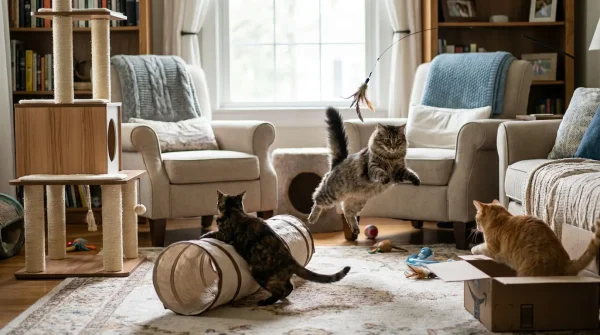Understanding Feline Urinary Health: A Complete Guide to Royal Canin Urinary S/O Diet

Understanding Feline Urinary Health: A Complete Guide to Royal Canin Urinary S/O Diet
Feline urinary tract problems are among the most common health issues affecting cats today. From painful bladder infections to dangerous struvite stones, these conditions can significantly impact your cat’s quality of life. Fortunately, veterinary nutrition has advanced dramatically, and prescription diets like Royal Canin Veterinary Cat – Urinary S/O offer targeted solutions to support urinary health and prevent recurring problems.
What Is Feline Lower Urinary Tract Disease (FLUTD)?
Feline Lower Urinary Tract Disease (FLUTD) is an umbrella term describing several conditions affecting a cat’s bladder and urethra. These include:
- Crystalluria: Formation of crystals in urine
- Urolithiasis: Development of bladder stones (struvite or calcium oxalate)
- Feline Idiopathic Cystitis (FIC): Inflammation without infection
- Urinary Tract Infections (UTIs): Bacterial infections
- Urethral Obstruction: Blockage preventing urination (life-threatening emergency)
Symptoms to watch for include frequent urination, straining to urinate, blood in urine, urinating outside the litter box, and excessive licking of the genital area. If your cat shows any of these signs, immediate veterinary attention is essential.
Understanding Struvite Stones in Cats
Struvite stones are mineral formations that develop in a cat’s bladder when urine becomes too alkaline and concentrated. These stones can cause significant discomfort, block urine flow, and may require surgical removal if they become too large. Risk factors include:
- Dehydration or low water intake
- High magnesium, phosphorus, and protein diets
- Reduced urination frequency
- Sedentary lifestyle and obesity
- Stress and environmental factors
The good news? Struvite stones can often be dissolved through dietary management rather than surgery, which is where prescription therapeutic diets play a crucial role.
How Royal Canin Urinary S/O Works
Royal Canin Veterinary Cat – Urinary S/O is specifically formulated with Relative Super Saturation (RSS) technology to create an optimal urinary environment that dissolves existing struvite stones and prevents new crystal formation.
Key Mechanisms:
1. Urine Dilution: Increased water content in the food and balanced minerals encourage higher urine volume, which naturally dilutes crystal-forming substances.
2. Controlled Mineral Levels: Precisely controlled magnesium (0.04%), phosphorus (0.5%), and sodium (0.6%) levels reduce the building blocks for struvite crystal formation.
3. Urine Acidification: The diet helps maintain urine pH between 6.0-6.3, creating an environment where struvite stones dissolve and cannot reform.
4. Anti-Inflammatory Support: Added omega-3 fatty acids (EPA and DHA) help reduce inflammation in the urinary tract, supporting cats with idiopathic cystitis.
Clinical studies show that struvite stones can dissolve in as little as 27 days on average when cats are fed Royal Canin Urinary S/O exclusively.
Who Should Use Royal Canin Urinary S/O?
This veterinary-exclusive diet is recommended for:
- Cats with diagnosed struvite urolithiasis
- Cats prone to recurring urinary crystals
- Cats with feline idiopathic cystitis (FIC)
- Cats with a history of FLUTD who need preventive nutrition
Important: This is a prescription veterinary diet available exclusively through veterinary clinics and authorized retailers. You must consult your veterinarian for diagnosis, authorization, and monitoring. The diet should be fed as the sole food source under veterinary supervision.
Feeding Guidelines and Transition
To dissolve existing struvite stones, feed Royal Canin Urinary S/O exclusively for 5-12 weeks. For prevention of recurrence, it can be fed long-term.
Transition Schedule:
Gradually transition your cat over 7 days to avoid digestive upset:
- Days 1-2: 25% new diet, 75% old diet
- Days 3-4: 50% new diet, 50% old diet
- Days 5-6: 75% new diet, 25% old diet
- Day 7: 100% new diet
Daily feeding amounts vary based on your cat’s weight and body condition. Your veterinarian will provide precise feeding recommendations.
What Makes Royal Canin Different?
Royal Canin has pioneered veterinary therapeutic nutrition for over 50 years. Their commitment to scientific research and veterinary partnerships ensures each formula addresses specific health conditions with precision.
The Urinary S/O formulation exemplifies this approach:
- Evidence-Based: Backed by clinical trials demonstrating efficacy
- Quality Ingredients: Brewers rice, corn gluten meal, chicken by-product meal, and natural flavors provide balanced nutrition
- Complete Nutrition: Despite being therapeutic, it provides complete daily nutrition
- Palatability: Formulated to appeal to cats’ taste preferences, ensuring compliance
Complementary Care for Urinary Health
While Royal Canin Urinary S/O addresses the nutritional aspect, comprehensive urinary health management includes:
1. Hydration
Encourage water intake through multiple water stations, water fountains, or adding water to food. Proper hydration dilutes urine naturally.
2. Stress Reduction
Stress is a major trigger for idiopathic cystitis. Provide environmental enrichment, quiet spaces, and consistent routines.
3. Litter Box Management
Keep litter boxes clean, provide one box per cat plus one extra, and use unscented litter. Dirty boxes can discourage urination, increasing concentration.
4. Regular Veterinary Check-Ups
Follow-up appointments allow your vet to monitor urine pH, crystal presence, and overall response to treatment through urinalysis and imaging.
Precautions and Contraindications
Royal Canin Urinary S/O should NOT be fed to:
- Kittens (growing cats have different nutritional needs)
- Pregnant or lactating cats
- Cats with chronic kidney disease, heart disease, or liver disease (unless specifically recommended by your vet)
- Cats with hyperlipidaemia
- Cats concurrently receiving urinary acidifiers
- Cats with calcium oxalate stones (different dietary approach needed)
Always provide your veterinarian with complete medical history before starting any prescription diet.
The Cost of Prevention vs. Treatment
While prescription diets may seem expensive initially, they are significantly more cost-effective than treating urinary emergencies:
- Emergency vet visits for urethral obstruction: €500-€1,500
- Surgical stone removal: €800-€2,000
- Hospitalization and supportive care: €300-€800 per day
- Prescription diet: Approximately €1-2 per day
Investing in preventive nutrition protects both your cat’s health and your wallet.
Real-World Success
Veterinary practices worldwide report high success rates with Royal Canin Urinary S/O. Cats that previously experienced recurring FLUTD episodes often show dramatic improvement within weeks of dietary change. Pet owners frequently report their cats become more comfortable, active, and exhibit normal urination patterns.
One Irish veterinary clinic reported that 85% of cats with struvite stones showed complete dissolution within 6-8 weeks on Royal Canin Urinary S/O, with only 5% experiencing recurrence within two years when maintained on preventive feeding.
Conclusion
Feline urinary health issues are serious but manageable conditions. Early recognition, veterinary diagnosis, and appropriate nutritional intervention with diets like Royal Canin Urinary S/O can dramatically improve outcomes and quality of life for affected cats.
If you suspect your cat has urinary problems, don’t delay seeking veterinary care. FLUTD can progress quickly, and early intervention is key. Once your veterinarian diagnoses the specific condition and recommends Royal Canin Urinary S/O, you can purchase this prescription diet through authorized channels with proper veterinary authorization.
Remember: urinary health is not just about treating problems—it’s about creating an environment where they cannot develop in the first place. With proper nutrition, hydration, and care, your cat can enjoy a comfortable, active life free from urinary tract complications.
Always consult your veterinarian before starting any prescription diet. This article is for informational purposes and does not replace professional veterinary advice.





